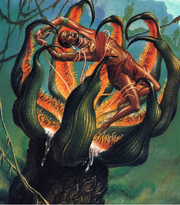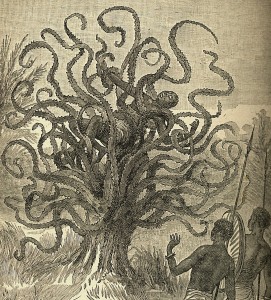No edit summary Tags: Visual edit apiedit |
No edit summary Tags: Visual edit apiedit |
||
| Line 1: | Line 1: | ||
[[File:Carnivorous_Tree.jpg|thumb|300px]] |
[[File:Carnivorous_Tree.jpg|thumb|300px]] |
||
| − | A '''Man- |
+ | A '''Man-Eating Tree''' or '''Carnivorous Tree''' can refer to any of the many legendary or cryptozoological carnivorous plants that are large enough to kill and consume a person or other large animal. In actuality, the carnivorous plant with the largest known traps is probably the Nepethes Raja, which produces pitchers up to 38 cm (15 in) tall with a volume of up to 3.5 litres (0.77 imp gal; 0.92 US gal). This species traps small mammals. However, pitcher plants are leeches off trees, not large enough to consume people. In popular culture it is common. |
==Madagascar == |
==Madagascar == |
||
{{Main |
{{Main |
||
|The Madagascar Tree}} |
|The Madagascar Tree}} |
||
| − | The earliest well known report of a |
+ | The earliest well known report of a Man-Eating Tree originated in the 1800s. In 1881 German explorer "Carl Liche" wrote an account in the South |
[[File:The_Madagascar_tree.png|thumb|left|The Madagascar form]] |
[[File:The_Madagascar_tree.png|thumb|left|The Madagascar form]] |
||
Revision as of 20:27, 1 April 2015

A Man-Eating Tree or Carnivorous Tree can refer to any of the many legendary or cryptozoological carnivorous plants that are large enough to kill and consume a person or other large animal. In actuality, the carnivorous plant with the largest known traps is probably the Nepethes Raja, which produces pitchers up to 38 cm (15 in) tall with a volume of up to 3.5 litres (0.77 imp gal; 0.92 US gal). This species traps small mammals. However, pitcher plants are leeches off trees, not large enough to consume people. In popular culture it is common.
Madagascar
- Main article: The Madagascar Tree
The earliest well known report of a Man-Eating Tree originated in the 1800s. In 1881 German explorer "Carl Liche" wrote an account in the South

The Madagascar form
Australian Register of encountering a sacrifice performed by the "Mkodo" tribe of Madagascar. "The slender delicate palps, with the fury of starved serpents, quivered a moment over her head, then as if with instinct and demonic intelligence fastened upon her in sudden coils round and round her neck and arms; then while her awful screams and yet more awful laughter rose wildly to be instantly strangled down again into a gurgling moan, the tendrils one after another, like great green serpents, with brutal energy and infernal rapidity, rose, retracted themselves, and wrapped her about in fold after fold, ever tightening with cruel swiftness and savage tenacity of anacondas fastening upon their prey." The tree was given further publicity by the 1924 book by former Governor of Michigan Chase Osborn, Madagascar, Land of the Man-eating Tree. Osborn claimed that both the tribes and missionaries on Madagascar knew about the hideous tree, and also repeated the above Liche account.
Ya-Te-Veo
- Main article: The Ya-Te-Veo

Ya-Te-Veo
In J. W. Buel's Land and Sea (1887), the Ya-te-veo ("I-see-you-already") plant is said to catch and consume large insects, but also attempts to consume humans.
It is said to be a carnivorous plant that grows in parts of Central and South America with cousins in Africa and on the shores of the Indian Ocean. There are many different descriptions of the plant, but most reports say it has a short, thick trunk and long tendril like appendages which are used to catch prey. Some even claim it has an eye to locate it's prey with.
The natives feared it like it had bad omens and was thought to be the work of evil witch doctor magic.
